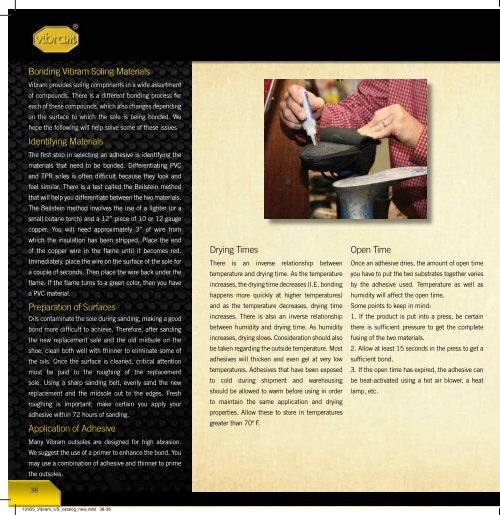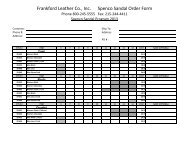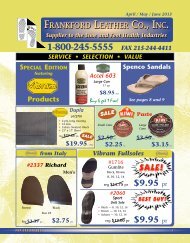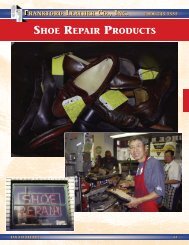12955_Vibram_US_catalog_new.indd 1 5/24/12 2:21 PM
Vibram Shoe Repair
Vibram Shoe Repair
- No tags were found...
You also want an ePaper? Increase the reach of your titles
YUMPU automatically turns print PDFs into web optimized ePapers that Google loves.
Bonding / POP Materials / Conversion Chart<br />
Bonding <strong>Vibram</strong> Soling Materials<br />
<strong>Vibram</strong> provides soling components in a wide assortment<br />
of compounds. There is a different bonding process for<br />
each of these compounds, which also changes depending<br />
on the surface to which the sole is being bonded. We<br />
hope the following will help solve some of these issues<br />
Identifying Materials<br />
The first step in selecting an adhesive is identifying the<br />
materials that need to be bonded. Differentiating PVC<br />
and TPR soles is often difficult because they look and<br />
feel similar. There is a test called the Beilstein method<br />
that will help you differentiate between the two materials.<br />
The Beilstein method involves the use of a lighter (or a<br />
small butane torch) and a <strong>12</strong>” piece of 10 or <strong>12</strong> gauge<br />
copper. You will need approximately 3” of wire from<br />
which the insulation has been stripped. Place the end<br />
of the copper wire in the flame until it becomes red.<br />
Immediately, place the wire on the surface of the sole for<br />
a couple of seconds. Then place the wire back under the<br />
flame. If the flame turns to a green color, then you have<br />
a PVC material.<br />
Preparation of Surfaces<br />
Oils contaminate the sole during sanding, making a good<br />
bond more difficult to achieve. Therefore, after sanding<br />
the <strong>new</strong> replacement sole and the old midsole on the<br />
shoe, clean both well with thinner to eliminate some of<br />
the oils. Once the surface is cleaned, critical attention<br />
must be paid to the roughing of the replacement<br />
sole. Using a sharp sanding belt, evenly sand the <strong>new</strong><br />
replacement and the midsole out to the edges. Fresh<br />
roughing is important; make certain you apply your<br />
adhesive within 72 hours of sanding.<br />
Application of Adhesive<br />
Many <strong>Vibram</strong> outsoles are designed for high abrasion.<br />
We suggest the use of a primer to enhance the bond. You<br />
may use a combination of adhesive and thinner to prime<br />
the outsoles.<br />
Drying Times<br />
There is an inverse relationship between<br />
temperature and drying time. As the temperature<br />
increases, the drying time decreases (I.E. bonding<br />
happens more quickly at higher temperatures)<br />
and as the temperature decreases, drying time<br />
increases. There is also an inverse relationship<br />
between humidity and drying time. As humidity<br />
increases, drying slows. Consideration should also<br />
be taken regarding the outside temperature. Most<br />
adhesives will thicken and even gel at very low<br />
temperatures. Adhesives that have been exposed<br />
to cold during shipment and warehousing<br />
should be allowed to warm before using in order<br />
to maintain the same application and drying<br />
properties. Allow these to store in temperatures<br />
greater than 70º F.<br />
Open Time<br />
Once an adhesive dries, the amount of open time<br />
you have to put the two substrates together varies<br />
by the adhesive used. Temperature as well as<br />
humidity will affect the open time.<br />
Some points to keep in mind:<br />
1. If the product is put into a press, be certain<br />
there is sufficient pressure to get the complete<br />
fusing of the two materials.<br />
2. Allow at least 15 seconds in the press to get a<br />
sufficient bond.<br />
3. If the open time has expired, the adhesive can<br />
be heat-activated using a hot air blower, a heat<br />
lamp, etc.<br />
Compound<br />
Suggested Adhesive<br />
Fire & Ice<br />
Urethane<br />
SBR<br />
Neoprene<br />
TC1<br />
Neoprene<br />
TC4<br />
Neoprene<br />
Nitrile<br />
Neoprene<br />
SP<br />
Neoprene<br />
Idrogrip<br />
Urethane<br />
Mont<br />
Neoprene<br />
Gumlite<br />
Neoprene<br />
Morflex<br />
Neoprene<br />
Newflex<br />
Neoprene<br />
Blown Rubber<br />
Neoprene<br />
PU<br />
Urethane<br />
SO<br />
Neoprene<br />
MS<br />
Neoprene<br />
NR<br />
Neoprene<br />
IR<br />
Urethane<br />
Grip<br />
Urethane<br />
Top 85<br />
Neoprene<br />
Snow<br />
Neoprene<br />
Disclaimer: These are suggested adhesives, results may differ<br />
<strong>Vibram</strong> ® Repair Tag<br />
Packaging:<br />
5,000 tags per carton<br />
numbered 001-5000<br />
and numbered<br />
5001 - 10,000<br />
Remarks: Blank space provided on tag for<br />
shop name, address and telephone<br />
number. Tag number on top and<br />
bottom.<br />
Made in U.S.A.<br />
Tag Size: 2-7/8" x 5-5/8"<br />
Material: Yellow Card Stock<br />
Ink:<br />
Black ink printed on two sides<br />
Perforation: One easy tear perforation<br />
the width of tag<br />
Reinforced Hole: 3/16"<br />
Conversion Chart<br />
Iron Fraction Inches mm Iron<br />
1 1/48 0.02083 0.529 1<br />
3 1/16 0.063 1.6 3<br />
4 0.083 2.1 4<br />
4.5 0.094 2.4 4.5<br />
5 0.104 2.7 5<br />
6 1/8 0.<strong>12</strong>5 3.2 6<br />
7 0.146 3.7 7<br />
8 0.167 4.2 8<br />
9 3/16 0.188 4.8 9<br />
10.5 0.<strong>21</strong>9 5.6 10.5<br />
<strong>12</strong> 1/4 0.250 6.4 <strong>12</strong><br />
14 0.292 7.4 14<br />
15 5/16 0.3<strong>12</strong> 8.0 15<br />
16 0.333 8.5 16<br />
17 0.354 9.0 17<br />
18 3/8 0.375 9.6 18<br />
<strong>21</strong> 7/16 0.437 11.2 <strong>21</strong><br />
<strong>24</strong> 1/2 0.500 <strong>12</strong>.7 <strong>24</strong><br />
27 9/16 0.562 14.3 27<br />
30 5/8 0.625 15.9 30<br />
33 11/16 0.687 17.5 33<br />
36 3/4 0.750 19.0 36<br />
39 13/16 0.813 20.6 39<br />
42 7/8 0.875 22.2 42<br />
45 15/16 0.938 23.8 45<br />
48 1 1.000 25.4 48<br />
54 1-1/8 1.<strong>12</strong>5 28.6 54<br />
60 1-1/4 1.250 31.7 60<br />
38<br />
39<br />
<strong><strong>12</strong>955</strong>_<strong>Vibram</strong>_<strong>US</strong>_<strong>catalog</strong>_<strong>new</strong>.<strong>indd</strong> 38-39<br />
5/<strong>24</strong>/<strong>12</strong> 2:23 <strong>PM</strong>








